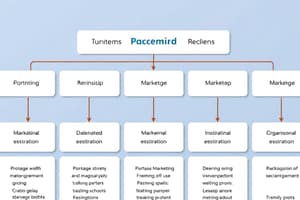Podcast
Questions and Answers
The word 'strategy' is derived from the Greek word stratus (meaning army) and 'ago' (meaning ______)
The word 'strategy' is derived from the Greek word stratus (meaning army) and 'ago' (meaning ______)
leading/moving
Strategy is an action that managers take to attain one or more of the organization’s ______
Strategy is an action that managers take to attain one or more of the organization’s ______
goals
Strategy is a well-defined roadmap of an ______
Strategy is a well-defined roadmap of an ______
organization
Strategy defines the overall mission, vision, and directions of an ______
Strategy defines the overall mission, vision, and directions of an ______
The objective of a strategy is to maximize an organization’s strengths and to minimize the strengths of the ______
The objective of a strategy is to maximize an organization’s strengths and to minimize the strengths of the ______
Strategy deals with long-term developments rather than ______ operations
Strategy deals with long-term developments rather than ______ operations
Without a perfect foresight, firms must be ready to deal with ______ events which constitute the business environment.
Without a perfect foresight, firms must be ready to deal with ______ events which constitute the business environment.
Strategies dealing with employees will predict the employee ______.
Strategies dealing with employees will predict the employee ______.
Components of a Strategy Statement include Vision, Mission, Goals, and ______.
Components of a Strategy Statement include Vision, Mission, Goals, and ______.
Strategy is created to take into account the probable behavior of ______ and competitors.
Strategy is created to take into account the probable behavior of ______ and competitors.
Strategy deals with long-term developments rather than routine ______.
Strategy deals with long-term developments rather than routine ______.
The word 'strategy' is derived from the Greek word stratus (meaning army) and 'ago' (meaning leading/______).
The word 'strategy' is derived from the Greek word stratus (meaning army) and 'ago' (meaning leading/______).
Core Values: Identifies the fundamental beliefs and principles that guide the organization's behavior and ______-making.
Core Values: Identifies the fundamental beliefs and principles that guide the organization's behavior and ______-making.
Target Market or Audience: Specifies the customers, clients, or stakeholders that the organization aims to serve or ______.
Target Market or Audience: Specifies the customers, clients, or stakeholders that the organization aims to serve or ______.
Competitive Advantage: Highlights the unique strengths, capabilities, or advantages that set the organization apart from its ______.
Competitive Advantage: Highlights the unique strengths, capabilities, or advantages that set the organization apart from its ______.
Key Initiatives or Strategies: Articulates the major approaches or actions that the organization will take to achieve its goals and fulfill its ______.
Key Initiatives or Strategies: Articulates the major approaches or actions that the organization will take to achieve its goals and fulfill its ______.
Vision and Mission Vision: Definition: The vision statement outlines the organization's long-term aspirations and what it aims to achieve in the ______.
Vision and Mission Vision: Definition: The vision statement outlines the organization's long-term aspirations and what it aims to achieve in the ______.
Mission: Purpose and Present Focus: The mission statement outlines the organization's fundamental purpose or reason for ______.
Mission: Purpose and Present Focus: The mission statement outlines the organization's fundamental purpose or reason for ______.




